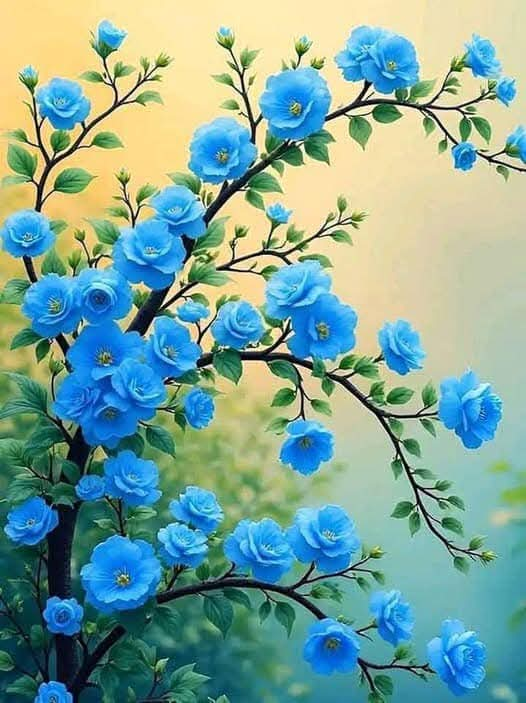Blue flowers are some of the rarest in nature, making them incredibly fascinating. Their cool, calming hue symbolizes tranquility, mystery, and the unattainable. Whether in art, folklore, or gardening, blue blooms have a special place in our hearts.
Are Blue Flowering Trees Real?
While this image is likely digitally created, some trees and shrubs naturally produce blue or blue-toned flowers. Here are a few real-life plants that resemble the breathtaking flowers in the image:
- Blue Jacaranda (Jacaranda mimosifolia)
One of the most famous blue-flowering trees.
Produces stunning clusters of lavender-blue trumpet-shaped flowers.
Commonly found in South America, California, and Australia.
- Blue Plumbago (Plumbago auriculata)
A vining shrub with delicate sky-blue flowers.
Native to South Africa and thrives in warm climates.
- Himalayan Blue Poppy (Meconopsis betonicifolia)
Not a tree but a rare blue-flowering plant.
Requires cool, moist conditions to thrive.
- Butterfly Pea Flower (Clitoria ternatea)
A fast-growing vine with deep blue flowers.
Used to make blue herbal tea with pH-sensitive color-changing properties.
The Symbolism of Blue Flowers
Throughout history, blue flowers have been associated with dreams, inspiration, and the unattainable. Here’s what they symbolize:
🌿 Tranquility & Peace – Blue flowers evoke a sense of calm and relaxation.
🌿 Mystery & Fantasy – Their rarity in nature makes them feel otherworldly.
🌿 Love & Devotion – In some cultures, blue flowers represent eternal love.
🌿 Spiritual Awakening – The blue lotus in Buddhism symbolizes enlightenment.
💡 Fun Fact: In literature, the “blue flower” is a symbol of romantic longing and the pursuit of the impossible, often appearing in poetry and fairy tales.
How to Grow Blue Flowers in Your Garden
If you love the idea of blue flowers in your garden, here are some tips for growing real blue-flowering plants:
✔ Choose the Right Plant: Consider climate, soil, and space for the best species.
✔ Soil pH Matters: Some flowers, like hydrangeas, turn blue in acidic soil (pH below 5.5).
✔ Provide Full Sun: Most blue-flowering plants thrive with at least 6 hours of sunlight daily.
✔ Use Organic Fertilizers: To enhance blue tones, use compost, coffee grounds, or aluminum sulfate.
Final Thoughts: A Dreamy Garden Awaits
While this exact blue-flowering tree may be artistic or digitally enhanced, nature offers many breathtaking blue flowers to add to your garden. Whether you choose Jacaranda, Plumbago, or Blue Poppies, these plants will bring beauty, serenity, and uniqueness to your space.
Would you love to plant blue flowers in your garden? Let us know in the comments! 🌿💙
More Articles You Might Like
-
Texas Toast Sloppy Joes: The Crunchy, Cheesy Upgrade You Didn’t Know You Needed
There’s something timeless about sloppy joes. For generations, this saucy, savory, and slightly sweet ground beef sandwich has been a go-to comfort food in American kitchens. It’s quick, filling, and family-friendly—perfect for busy weeknights. But what if we told you there’s a way to take this classic dish up a notch? Enter the Texas Toast…
-
Classic Pig Pickin’ Cake
When it comes to Southern desserts, few sweets shine as brightly as the Classic Pig Pickin’ Cake. This nostalgic cake, sometimes called a “Mandarin Orange Cake,” has roots deep in Southern tradition. It gets its playful name from its frequent appearance at pig pickin’s—Southern-style barbecue gatherings where communities come together to enjoy slow-cooked pork, sides,…
-
Lemon Garlic Butter Chicken with Creamy Parmesan Pasta
There’s something irresistible about the combination of tender, golden-browned chicken paired with a creamy pasta coated in Parmesan cheese. Add the brightness of lemon, the depth of garlic, and the richness of butter, and you have a recipe that feels indulgent yet approachable enough for a weeknight dinner. Lemon Garlic Butter Chicken with Creamy Parmesan…



